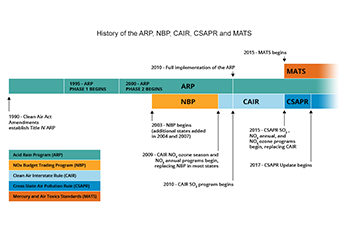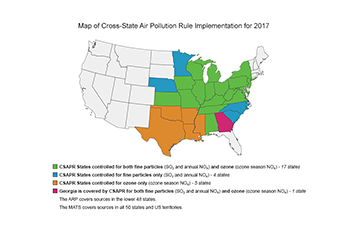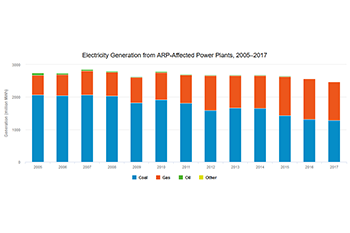Progress Report
Program Basics
Program Basics Figures
Last updated: 06/2019
Related Figures



Highlights
Acid Rain Program (ARP): 1995 - present
- ARP began in 1995 and covers fossil fuel-fired power plants across the contiguous United States. ARP was established under Title IV of the 1990 Clean Air Act Amendments and is designed to reduce SO₂ and NOₓ emissions, the primary precursors of acid rain.
- The ARP’s market-based SO₂ cap and trade program sets an annual cap on the total amount of SO₂ that may be emitted by covered electricity generating units (EGUs) throughout the contiguous U.S. The final annual SO₂ emissions cap was set at 8.95 million tons in 2010, a level of about one-half of the emissions from the power sector in 1980.
- NOₓ reductions under ARP are achieved through a rate-based approach that applies to a subset of coal-fired EGUs.
Cross-State Air Pollution Rule (CSAPR): 2015 - present
- CSAPR addresses regional interstate transport of fine particle and ozone pollution for the 1997 ozone and PM₂.₅ NAAQS and the 2006 PM₂.₅ NAAQS. In 2015, CSAPR required a total of 28 eastern states to reduce SO₂ emissions, annual NOₓ emissions and/or ozone season NOₓ emissions. Specifically, CSAPR required reductions in annual emissions of SO₂ and NOₓ from power plants in 23 eastern states and reductions of NOₓ emissions during the ozone season from power plants in 25 eastern states.
- CSAPR includes four separate cap and trade programs to achieve these reductions: CSAPR SO₂ Group 1 and Group 2 trading programs, CSAPR NOₓ Annual trading program, and CSAPR NOₓ Ozone Season Group 1 trading program.
Cross-State Air Pollution Rule Update (CSAPR Update): 2017 - present
- CSAPR Update was developed to address regional interstate transport for the 2008 ozone NAAQS and to respond to the July 2015 court remand of certain CSAPR ozone season requirements.
- Starting in May 2017, CSAPR Update began further reducing ozone season NOₓ emissions from power plants in 22 states in the eastern U.S.
- CSAPR Update achieves these reductions through the CSAPR NOₓ Ozone Season Group 2 trading program. The total CSAPR Update budget equals the sum of the individual state budgets for those states included in the program. The CSAPR Update budget is set at 316,464 tons in 2017.
CSAPR and CSAPR Update Budgets
- The total CSAPR and CSAPR Update budget for each of the five trading programs equals the sum of the individual state budgets for those states affected by each program. In 2017, some original CSAPR budgets tightened, particularly in the SO₂ Group 1 program. Also, CSAPR Update replaced the original CSAPR ozone season NOₓ program for most states. The total budget for each program was set at the following level in 2017:
- SO₂ Group 1 – 1,372,631 tons
- SO₂ Group 2 – 597,579 tons
- NOₓ Annual – 1,069,256 tons
- NOₓ Ozone Season Group 1 – 24,041 tons1
- NOₓ Ozone Season Group 2 – 316,464 tons
Mercury and Air Toxics Standards (MATS)
- EPA announced standards to limit mercury, acid gases, and other toxic pollution from power plants in December 2011 (published in February 2012). EPA provided the maximum 3-year compliance period so sources were generally required to comply no later than April 16, 2015. Some sources obtained a one-year extension from their state permitting authority, allowed under the CAA, and so, were required to comply with the final rule by April 16, 2016.
- Units subject to MATS must comply with emission rate limits for certain hazardous air pollutants (or surrogates). There are several ways to demonstrate compliance, including the use of continuous monitoring or through periodic measurement of emissions. Some units may choose to demonstrate compliance through periodic performance tests.
- This 2017 progress report only provides data from affected sources that submitted hourly emissions data in 2017. Units not reporting data (e.g. those monitoring using periodic testing) are not included in this report.
- The CSAPR NOₓ Ozone Season Group 1 program applies only to sources in Georgia.
Background Information
Power Sector Trends
The widespread and dramatic emission reductions in the power sector over the last few decades have come about from several factors, including changes in markets for fuels and electricity as well as regulatory programs. While most coal-fired electricity generation comes from sources with state of the art emission controls, broad industry shifts from coal-fired generation to gas-fired generation as well as increases in zero-emitting generation sources also have reduced power sector emissions. Market factors, reduced electricity demand, and policy and regulatory efforts have resulted in a notable change in the last decade to the country’s overall generation mix as natural gas and renewable energy generation increased while coal-fired generation decreased.
Looking ahead, the price of natural gas is expected to remain low for the foreseeable future as improvements in drilling technologies and techniques continue to reduce the cost of extraction. In addition, the existing fleet of coal-fired EGUs is aging and there are very few new coal-fired generation projects under development. With a continued (but reduced) tax credit and declining capital costs, solar capacity is projected to grow through 2050, while tax credits that phase out for plants entering service through 2024 provide incentives for new wind capacity in the near-term. Some power generators have announced that they expect to continue to change their generation mix away from coal-fired generation and toward natural-gas fired generation, renewables, and more deployment of energy efficiency measures. All of these factors, in total, have resulted in declining power sector emissions in recent years, a trend that is expected to continue going forward.
Acid Rain Program
Title IV of the 1990 Clean Air Act Amendments established ARP to address acid deposition nationwide by reducing annual SO₂ and NOₓ emissions from fossil fuel-fired power plants. In contrast to traditional command and control regulatory methods that establish specific emissions limitations, the ARP SO₂ program introduced a landmark allowance trading system that harnessed the economic incentives of the market to reduce pollution. This market-based cap and trade program was implemented in two phases. Phase I began in 1995 and affected the most polluting coal-burning units in 21 eastern and midwestern states. Phase II began in 2000 and expanded the program to include other units fired by coal, oil, and gas in the contiguous U.S. Under Phase II, Congress also tightened the annual SO₂ emissions cap, with a permanent annual cap set at 8.95 million allowances starting in 2010. The NOₓ program has a similar results-oriented approach and ensures program integrity through measurement and reporting. However, it does not cap NOₓ emissions, nor does it utilize an allowance trading system. Instead, ARP NOₓ program provisions apply boiler-specific NOₓ emission limits – or rates – in pounds per million British thermal units (lb/mmBtu) on certain coal-fired boilers. There is a degree of flexibility, however. Units under common control can comply through the use of emission rate averaging plans, subject to requirements ensuring that the total mass emissions from the units in an averaging plan do not exceed the total mass emissions the units would have emitted at their individual emission rate limits.
NOₓ Budget Trading Program
NBP was a market-based cap and trade program created to reduce NOₓ emissions from power plants and other large stationary combustion sources during the summer ozone season to address regional air pollution transport that contributes to the formation of ozone in the eastern United States. The program, which operated during the ozone seasons from 2003 to 2008, was a central component of the NOₓ State Implementation Plan (SIP) Call, promulgated in 1998, to help states attain the 1997 ozone NAAQS. All 21 jurisdictions (20 states plus Washington, D.C.) covered by the NOₓ SIP Call opted to participate in NBP. In 2009, CAIR's NOₓ ozone season program began, effectively replacing NBP to continue achieving ozone season NOₓ emission reductions from the power sector.
Clean Air Interstate Rule
CAIR required 25 eastern jurisdictions (24 states plus Washington, D.C.) to limit annual power sector emissions of SO₂ and NOₓ to address regional interstate transport of air pollution that contributes to the formation of fine particulates. It also required 26 jurisdictions (25 states plus Washington, D.C.) to limit power sector ozone season NOₓ emissions to address regional interstate transport of air pollution that contributes to the formation of ozone during the ozone season. CAIR used three separate market-based cap and trade programs to achieve emission reductions and to help states meet the 1997 ozone and fine particle NAAQS.
EPA issued CAIR on May 12, 2005 and the CAIR federal implementation plans (FIPs) on April 26, 2006. In 2008, the U.S. Court of Appeals for the DC Circuit remanded CAIR to the Agency, leaving existing CAIR programs in place while directing EPA to replace them as rapidly as possible with a new rule consistent with the Clean Air Act. The CAIR NOₓ ozone season and NOₓ annual programs began in 2009, while the CAIR SO₂ program began in 2010. As discussed below, CAIR was replaced by CSAPR in 2015.
Cross-State Air Pollution Rule
EPA issued CSAPR in July 2011, requiring 28 states in the eastern half of the United States to significantly improve air quality by reducing power plant emissions that cross state lines and contribute to fine particle and summertime ozone pollution in downwind states. CSAPR required 23 states to reduce annual SO₂ and NOₓ emissions to help downwind areas attain the 2006 and/or 1997 annual PM₂.₅ NAAQS. CSAPR also required 25 states to reduce ozone season NOₓ emissions to help downwind areas attain the 1997 ozone NAAQS. CSAPR divides the states required to reduce SO₂ emissions into two groups (Group 1 and Group 2). Both groups were required to reduce their SO₂ emissions in Phase I. All Group 1 states, as well as some Group 2 states, were required to make additional reductions in SO₂ emissions in Phase II in order to eliminate their significant contribution to air quality problems in downwind areas.
CSAPR was scheduled to replace CAIR starting on January 1, 2012. However, the timing of CSAPR's implementation was affected by D.C. Circuit actions that stayed and then vacated CSAPR before implementation. On April 29, 2014, the U.S. Supreme Court reversed the D.C. Circuit’s vacatur, and on October 23, 2014, the D.C. Circuit granted EPA’s motion to lift the stay and shift CSAPR compliance deadlines by three years. Accordingly, CSAPR Phase I implementation began on January 1, 2015, replacing CAIR, and CSAPR Phase II began January 1, 2017.
Cross-State Air Pollution Rule Update
On September 7, 2016, EPA finalized an update to CSAPR ozone season program by issuing the CSAPR Update. This rule addresses the summertime ozone pollution in the eastern U.S. that crosses state lines and will help downwind states and communities meet and maintain the 2008 ozone NAAQS. In May 2017, CSAPR Update began further reducing ozone season NOₓ emissions from power plants in 22 states in the eastern U.S.
Cross-State Air Pollution Rule Close-Out
Under the Clean Air Act’s “good neighbor” provision (section 110(a)(2)(D)(i)(I)), upwind states that contribute significantly to nonattainment or interfere with maintenance of NAAQS in downwind areas must implement emission reductions through a state implementation plan (SIP) or, in the absence of an approved SIP, a federal implementation plan (FIP). When issuing the CSAPR Update in September 2016, EPA found that, while it would result in meaningful, near-term reductions in ozone pollution that crosses state lines, the CSAPR Update may not be sufficient to fully address all covered states’ good neighbor obligations with respect to the 2008 ozone NAAQS. However, based on additional analysis conducted after issuance of the rule, EPA determined in December 2018 that the emission reductions required by the CSAPR Update in fact would fully address all covered states’ good neighbor obligations with respect to this NAAQS. As a result, the covered states do not need to submit SIPs to establish additional emission reduction requirements beyond the existing CSAPR Update requirements to further reduce transported ozone under the 2008 ozone NAAQS. Likewise, EPA has no obligation to establish additional emission reduction requirements for this purpose.
Mercury and Air Toxics Standards
On December 16, 2011, the EPA announced final standards to reduce emissions of toxic air pollutants from new and existing coal- and oil-fired electric utility steam generating units (EGUs) in all 50 states and U.S. territories. MATS established technology-based emission rate standards that reflect the level of hazardous air pollutant (HAP) emissions that had been achieved by the best-performing sources. These HAPs include mercury (Hg), non-mercury metals (such as arsenic (As), chromium (Cr), and nickel (Ni)), and acid gases, including hydrochloric acid (HCl) and hydrofluoric acid (HF). EPA provided the maximum 3-year compliance period so sources were generally required to comply no later than April 16, 2015. Some sources obtained a one-year extension from their state permitting authority, allowed under the CAA, and so, were required to comply with the final rule by April 16, 2016.
More Information
- Acid Rain Program (ARP)
- Interstate Air Pollution Transport
- Cross-State Air Pollution Rule (CSAPR)
- Cross-State Air Pollution Rule Update (CSAPR Update)
- Cross-State Air Pollution Rule Close-Out (CSAPR Close-Out)
- Clean Air Interstate Rule (CAIR)
- NOₓ Budget Trading Program (NBP) / NOₓ SIP Call
- National Ambient Air Quality Standards (NAAQS)
- EPA's Clean Air Market Programs
- Emissions Trading
- MATS